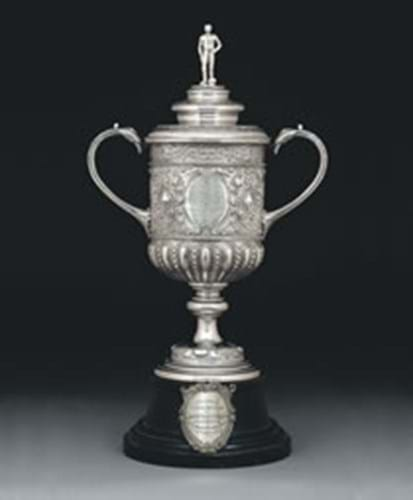
The adage was certainly borne out in the middle of May when more money changed hands in the field of sporting memorabilia sales than in any previous series, taking this market to a hitherto unseen financial level.
Over three days, more than £1.5m was spent at two sales at Graham Budd (15% buyer's premium) in association with Sotheby's on May 17 and 18 and one at Christie's South Kensington (20/12% buyer's premium) on the 19th. The record for any sporting item was broken twice in 48 hours, and Christie's netted their highest total ever for a sports sale when their football memorabilia auction on May 19 achieved a hammer figure of £994,630, thanks in no small part to the £420,000 return made from the FA Cup.
Indeed, the turn-out for Christie's sale was phenomenal. Spectators were crammed in right to the back of the saleroom and there was a scrum of photographers and broadcasters jostling for position to one side. Each big sports auction is getting more and more media attention than the last. This sale was covered on national radio and a live link was fed through for BBC News 24. Coverage was assured in every national newspaper, and a Christie's press officer admitted that this was by far and away his busiest day of the year to date.
By offering these prize lots, this sector can generate coverage that other areas of the market can only dream about. CSK's sale of British and Continental ceramics was going on at the same time in another room and, in truth, it seemed deserted by comparison.
And the publicity generated by these football sales is helping to fuel the market. In the public at large, it would be fair to say that there are many more football fans than there are art lovers, but turning these enthusiasts into buyers requires first making them aware that this market exists.
Christie's sports specialist David Convery said that gaining media attention was part of their strategy to attract new buyers. And judging by the results at their football sale this appears to have paid off - over three quarters of the 338 lots sold for an average value of just over £3000.
What was also clear from Graham Budd's sporting memorabilia sale on May 18 was that football is now the strongest sector of the sporting market, having outperformed golf over the past five years by an ever-growing margin. "As a market, football is about half as young as golf," said Graham Budd. "Whereas it's not as easy to find quality golf memorabilia that is fresh to the market these days, there's plenty of supply of football shirts, programmes and other objects."
Although the £318,790 total from the sale was helped by two outstanding golfing lots, it was the football items achieved the higher selling rate. This added to the £395,040 total made the day before from Graham Budd's sale of chattels from Ascot Racecourse, which included £280,000 from the magnificent entrance gates to the winners' enclosure. Reported on page two this week, the gates briefly held the sporting memorabilia record until they were eclipsed by the FA cup at Christie's two days later.
FA cup takes the pundits and creates sporting memorabilia history
Christie's timed their football memorabilia sale to take place on the Thursday before this year's cup final. By coinciding with the build-up to the Arsenal-Manchester United match on the weekend, the auctioneers had no problems creating press coverage for their star lot: the trophy used for the competition between 1896 and 1910.
Well-versed in promoting specific lots to certain buyers in the arts sector, Christie's simply adapted their client-targeting tactics to the sporting world.
Sending out catalogues to all premier league club chairmen proved a successful strategy. It emerged in the days after the sale that the telephone buyer of the cup was Birmingham City's millionaire owner David Gold. Although the 68-year-old Ann Summers lingerie chain proprietor claimed to have bought it "on behalf of the nation's football fans" to prevent it from going to Germany, there was in fact no foreign interest in this lot.
Selling for £420,000 against an anonymous underbidder, the cup set an auction record for any item of sporting memorabilia and, by beating the replica Jules Rimet trophy that made £230,000 in 1997, it almost doubled the price of the previous record for a sporting trophy.
The FA cup will be displayed at St Andrews next season, which means that the Birmingham supporters will finally be able to see the trophy in their ground since they have actually never won the cup. It literally flies in the face of those who say that money can't buy silverware.
This was in fact the second of the four FA cups that have been produced for presentation to the winners of the oldest competition in football. The first one was used between 1872 and 1895, until it was stolen in Birmingham after it was won by Aston Villa. It was never recovered and is thought to have been melted down to make counterfeit coins.
The cup at the Christie's sale was the second, an identical replacement, standing 18in (46cm) tall and made by Vaughton & Sons of Birmingham. It was consigned to Christie's by the descendants of Lord Kinnaird to whom it was given in 1911 to celebrate his 21st year as FA president.
The FA had withdrawn the cup from service in that year and replaced it with a new model because a Manchester silversmith had duplicated the cup's design and the Football Association, as it transpired, did not hold the copyright. This duplicated version, ironically, eventually ended up at the FA and is now in their Soho Square headquarters.
The third FA cup was used from 1911 until it needed replacing in 1991, while the fourth is still in service today.




